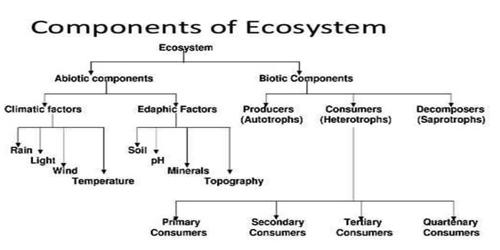Due to overpopulation, human habitation and the number of industries have increased. For this reason, the areas of traditional cultivable land and natural forests have decreased. Sound, smoke, industrial waste, garbage and bad smell of the factories, etc. are polluting the environment. As a result, the balance of the environment is being disrupted.
The different animals of the world are not only dependable on one another, they are also dependable upon the physical factors of the environment e.g. soil, water, air, and plants. For this reason, living beings cannot be separated from the nonliving. There is an intimate relationship between the living community and the non-living environment for survival. The interrelationship between organisms and their environment is ecology.

Components of Ecosystem
There are two main components of an ecosystem that are in constant communication with each other. They are the biotic components and the abiotic components.
Biotic Components of Ecosystem
The living components of an ecosystem are called the biotic components. Some of these factors include plants, animals, as well as fungi and bacteria. Producers, consumers, and decomposers are the three broad categories of biotic components.
- Producers are the plants in the ecosystem, which can generate their own energy requirement through photosynthesis, in the presence of sunlight and chlorophyll. All other living beings are dependent on plants for their energy requirement of food as well as oxygen.
- Consumers include herbivores, carnivores, and omnivores. The herbivores are the living organisms that feed on plants.
- Decomposers are the fungi and bacteria, which are the saprophytes. They feed on the decaying organic matter and convert this matter into nitrogen and carbon dioxide.
Abiotic Components of Ecosystem
Abiotic components are the physical and/or the chemical factors that act on the living organisms at any part of their life. They mainly take up the role of life supporter. These are also called as the ecological factors. The physical and chemical factors are characteristic of the environment. Light, air, soil, and nutrients, etc. form the abiotic components of an ecosystem. They determine and restrict the population growth, number, and diversity of biotic factors in an ecosystem.
We understand from the discussion above that ecosystem has two components. One is the biotic community and the other is the non-living environment. It is the non-living environment, which holds the biotic community. In any particular environment of a geographical region, the relationships and interactions between living and nonliving objects are collectively known as Eco-system.
Ecology can be classified into different types.
- Global Ecology – It is the study of interactions among earth’s ecosystems, atmosphere, land, and oceans.
- Landscape Ecology – It is the study of the exchange of energy, organisms, materials, and other products of ecosystems.
- Ecosystem Ecology – It is the study of the entire ecosystem which includes the study of living and non-living components and their relationship with the environment.
- Community Ecology – It is the study of how community structure is changed by interactions among living organisms.
- Population Ecology – It is the study of factors that change and impact the size and genetic composition of the population of organisms.
There are many practical applications of ecology in conservation biology, wetland management, natural resource management (agriculture, forestry, agroforestry, fisheries, etc.), city planning (urban ecology), community health, economics, basic and applied science, and human social interaction (human ecology). Ecosystems sustain life-supporting functions and produce natural capital, such as biomass production (food, fuel, fiber, and medicine), the regulation of climate, global biogeochemical cycles, water filtration, soil formation, erosion control, flood protection, and many other natural features of scientific, historical, economic, or intrinsic value.














